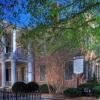The mission of the Raleigh Historic Development Commission is to identify, preserve, protect, and promote Raleigh’s historic resources.
Our Mission
Early Development, Prior to 1830 - Copy
A southern capital is established among plantations along a major north-south road.
This early period includes the founding of Raleigh in 1792 and continues through the first few decades of the nineteenth century. During this time, Raleigh grew little in population and remained essentially a government town. Architecture surviving from this earliest period of development in Raleigh generally includes properties that were well outside the city limits at the time of their construction. Raleigh, founded specifically for the purpose of being the state capital, was for several decades about a square mile in area: its city limits remained fixed at North, East, South, and West Streets until 1857.
In addition to these early buildings, much of Raleigh's 1792 street plan survives. Surveyor William Christmas's plan included Union Square (today the site of the State Capitol) with four main streets extending from the square: Hillsborough, Fayetteville, New Bern, and Halifax. Other streets formed a regular grid with Union Square near the center. Four smaller park squares also graced the plan; today, only Nash and Moore Squares remain open parks. The Executive Mansion stands on Burke Square and state government buildings occupy Caswell Square.

